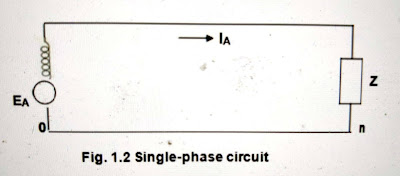FORMATION OF BUS IMPEDANCE MATRIX
NODE ELIMINATION BY MATRIX ALGEBRA
Nodes can be eliminated by the matrix manipulation of the standard node equations. However, only those nodes at which current does not enter or leave the network can be considered for such elimination. Such nodes can be eliminated either in one group or by taking the eligible nodes one after the other for elimination, as discussed next.
CASE-A: Simultaneous Elimination of Nodes:
Consider the performance equation of the given network in bus frame of reference in admittance form for a n-bus system, given by:
IBUS = YBUS EBUS (1)
Where IBUS and EBUS are n-vectors of injected bus current and bus voltages and YBUS is the square, symmetric, coefficient bus admittance matrix of order n. Now, of the n buses present in the system, let p buses be considered for node elimination so that the reduced system after elimination of p nodes would be retained with m (= n-p) nodes only. Hence the corresponding performance equation would be similar to (1) except that the coefficient matrix would be of order m now, i.e.,
IBUS = YBUSnew EBUS (2)
Where YBUSnew is the bus admittance matrix of the reduced network and the vectors
IBUS and EBUS are of order m. It is assumed in (1) that IBUS and EBUS are obtained with their elements arranged such that the elements associated with p nodes to be eliminated are in the lower portion of the vectors. Then the elements of YBUS also get located accordingly so that (1) after matrix partitioning yields,
Where the self and mutual values of YA and YD are those identified only with the nodes to be retained and removed respectively and YC=YBt is composed of only the corresponding mutual admittance values, that are common to the nodes m and p.
Now, for the p nodes to be eliminated, it is necessary that, each element of the vector IBUS-p should be zero. Thus we have from (3):
IBUS-m = YA EBUS-m + YB EBUS-p IBUS-p = YC EBUS-m + YD EBUS-p = 0
(4)
Solving,
EBUS-p = - YD-1YC EBUS-m (5)
Thus, by simplification, we obtain an expression similar to (2) as,
IBUS-m = {YA - YBYD-1YC} EBUS-m (6)
Thus by comparing (2) and (6), we get an expression for the new bus admittance matrix in terms of the sub-matrices of the original bus admittance matrix as:
YBUSnew = {YA – YBYD -1YC} (7)
This expression enables us to construct the given network with only the necessary nodes retained and all the unwanted nodes/buses eliminated. However, it can be observed from
(7) that the expression involves finding the inverse of the sub-matrix YD (of order p). This would be computationally very tedious if p, the nodes to be eliminated is very large, especially for real practical systems. In such cases, it is more advantageous to eliminate the unwanted nodes from the given network by considering one node only at a time for elimination, as discussed next.
CASE-B: Separate Elimination of Nodes:
Here again, the system buses are to be renumbered, if necessary, such that the node to be removed always happens to be the last numbered one. The sub-matrix YD then would be a single element matrix and hence it inverse would be just equal to its own reciprocal value. Thus the generalized algorithmic equation for finding the elements of the new bus admittance matrix can be obtained from (6) as,
Yij new = Yij old – Yin Ynj / Ynn " i,j = 1,2,…… n. (8)
Each element of the original matrix must therefore be modified as per (7). Further, this procedure of eliminating the last numbered node from the given system of n nodes is to be iteratively repeated p times, so as to eliminate all the unnecessary p nodes from the original system.












